The Olive tree
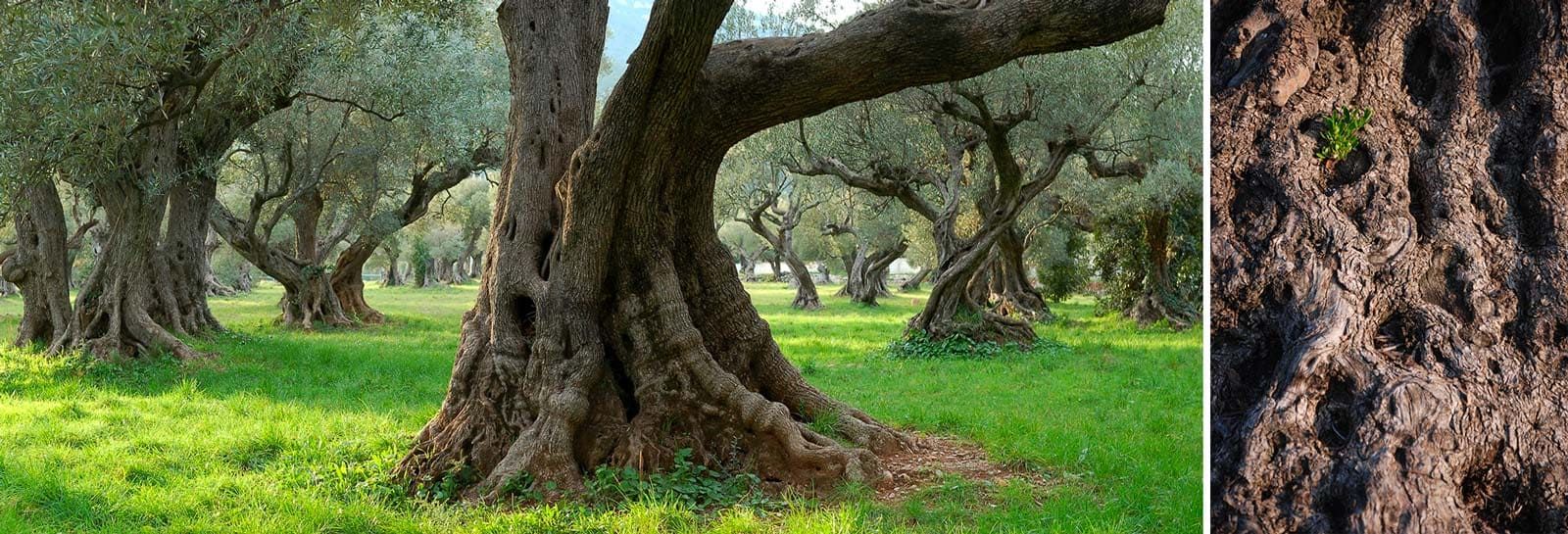
THE OLIVE TREE IN GENERAL
The Olive tree has many branches, a knotty trunk, a brown cracked bark and can reach a height of 15 to 20 metres and live hundreds of years. It adapts easily to arid, stony and barren grounds. Thanks to its ligneous stump in which it gathers its reserves and to its vast network of roots, it is very resistant. However, if the Olive tree retains the water that it has drawn from the ground a long time, it likes water and grows better if it is not lacking any. However, a saturated ground is a fatal danger to the tree. Its resistance to frost varies according to the time of year, the variety, how long the frost lasts and the size of the olive tree. The youngest cannot resist to -6° whereas the older trees can support a temperature of -12° à -15°C.
This tree does not die easily. Effectively, it puts up suckers in the worst conditions and even if its main tronc is dead, others stem from the stump and replace it. The Olive tree is highly aesthetic, and because of this, thousands of olive trees are cultivated for ornamental purposes and incredibly old Olive trees that have sometimes been abandoned on unexploited ground are bought by Nursery garden owners to be replanted and sold.
Certain of these Olive trees are unable to support the move and die, it is then up to me to transform them and give them a second life. Surrounded by legends that go back thousands of years and is a symbolic tree for civilizations all around the Mediterranean. Unfortunately, it is not possible to know the age of an Olive tree for certain. Dendrochronology (Tree ring dating) cannot be used on the stump of an Olive tree. This variety does not show any net individual growth circles.
The age of a tree can only be estimated by basing on indirect indications (diametre, aspect, historical documents, etc). But these elements are not truly viable. In its natural state, when an Olive tree becomes old, it produces shoots (called “suckers”) from its stump and, in this way never truly dies of old age. The new tree that replaces it is not another Olive tree, but a part of itself. Nonetheless, the Olive tree can die due to frost, sodden ground and probably also for reasons of drought.
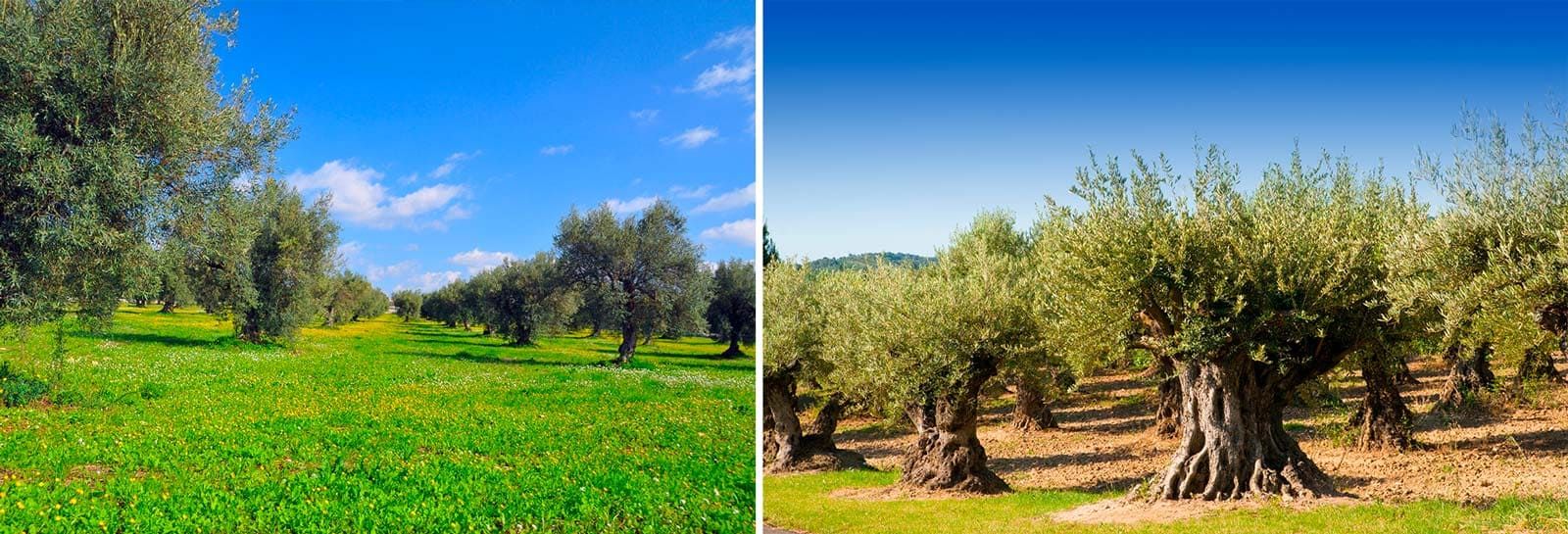
Classification
The Olive tree is classed in the family of Oleaceae which includes, amongst others, Lilacs (Syringa), Privet (Ligustrum), Ash trees (Fraxinus) as well as several shrubs. The gender is called Olea and is composed of 30 different species spread around the surface of the globe.
The variety cultivated around the Mediterranean is Olea Europaea, which includes numerous varieties and produces various shapes and savours of olives stemming from the Oleaster variety, otherwise known as the wild Olive tree.
Certain searchers have recently carried out an inventory and identified 156 varieties including a great number of characteristics relating to the tree, to the fruit bearing branches, the fruit, the inflorescence, down to the leaves and the endocarp.

VEGETATIVE CYCLE
- Vegetative rest: December-January, for 1 to 3 months.
Germinating activity stopped or slowed down. - Return of the vegetation: End of February, for 20 to 25 days.
Emission of new light-coloured vegetation. - Appearance of floral buds: Mid-March for 18 to 23 days.
Green inflorescence that whitens at maturity. - Blossoming: From the beginning of May to the 10th of June, for 7 days.
Open and clearly apparent Flowers. Pollination and fertilisation. - Fructification: End of May – June.
The petals fall, possible early disaster for flowers and fruit. - Development of the fruit: Second half of June for 3 to 4 weeks.
Small but clearly visible fruit. - Hardening of the stone: July for 7 to 25 days.
The end of the formation of the fruit that have become resistant to cutting and section. - Growth of the fruit: In August for 1.5 to 2 months.
Considerable increase in the size of the fruit and the appearance of lenticels. - The start of ripening: from mid-October to December.
At least half of the surface of the fruit turns from green to a violet red. - Full maturity: From the end of October to December.
The fruit is uniformly coloured in violet to black.
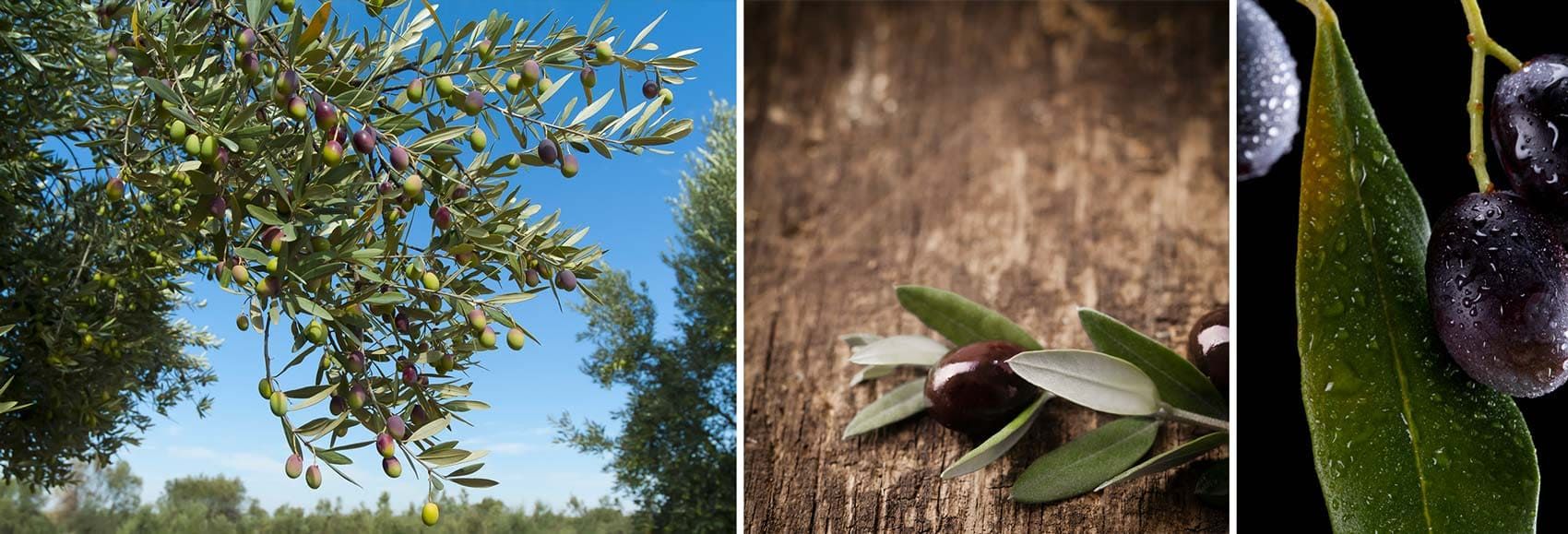
LEAVES
The leaves are positioned opposite each other, of a long oval shape and a shiny dark green on the upper side and light silver green with a medial vein on the lower side. The leaves are persistent, so always green but their duration of life, on an average is limited to three years. During a storm, the leaves turn up to expose the inferior structure to capture water, while their upper side is rather more specialized for photosynthesis. The inferior side is covered with tiny hairs that enable them to retain even the tiniest quantity of humidity while being exposed a maximum to the rays of sun. They measure 3 to 8 centimetres long according to the variety.
The leaves of the Olive tree withhold numerous properties having revealed an antiradical and appeasing activity. Rich in vitamin E and in oleanolic acid, the leaves of the Olive tree have been used for centuries for their properties, both orally and externally in beauty creams. Studies published in Japan in 2002 have proved the efficacy of the extract of olive leaves, in particularly against free radicals.
These are the unstable molecules which are permanently produced by the body. Body cells produce energy from nutrients and from oxygen but leave pollutants behind them: the free radicals. Due to the polluting function of the metabolism, these free radicals are toxic. We produce many more due to pollution, smoke, cigarettes, tiredness, stress, ultra-violet rays, ionising radiation, certain pesticides, solvents, fibreglass, and silica dust.
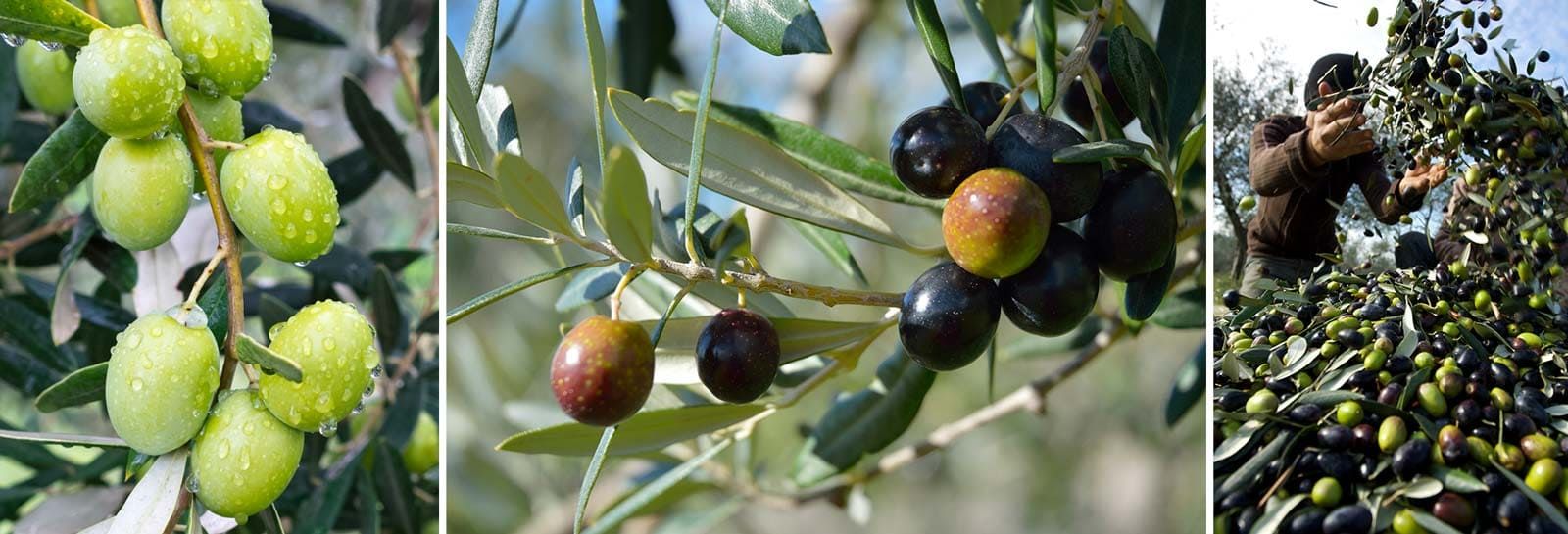
FLOWERS & FRUIT
The flowers are white with a corolla, a calyx with four oval shaped petals. The flowers are grouped into small grapes of 10 to 20 flowers, growing at the junction of the leaves at the beginning of Spring on two-year-old shoots.
Olive trees are auto-fertilising, this is to say that their own pollen can fertilise their own ovaries. Fertilisation is principally made by the wind and only lasts a short week per year. 5 to 10% of these flowers produce fruit for a good production.
Variety of Olives, the vintages:
- The “Aglandau”, very well known in France (Alpes de Haute Provence), is resistant to cold and diseases and gives a good yield of oil. Pronounced gustatory qualities.
- The “Bouteillan”, is very present in the Var, fairly resistant to cold and drought, less to diseases giving an average yield of oil. It has a slight pear taste.
- The “Cailletier”, in the Alpes-Maritimes, has an average resistance to cold and diseases with a good yield of oil, which has a gentle, light taste of almond and hazelnut.
- The “Olivière”, in the Pyrénées-Orientales, offers a good resistance to cold but less resistance to diseases. A less than average yield of oil that has a fruity (tomato) taste.
- The “Picholine”, in Hérault and the Gard. Not very resistant to cold but more resistant to diseases. Fairly good yield in oil. Very fruity and bitter gustatory qualities.
- The “Salonenque”, more particularly grown in the Bouches-du-Rhône. It resists averagely to cold but particularly well to diseases and presents an especially good yield in oil. It has a particularly gentle and delicate savour.
- The “Tanche”, more present in the Vaucluse and in the Drôme, resists averagely to cold and diseases but gives a particularly good yield in oil. Its flavour is gentle and can disappoint amateurs of more full-bodied oil.
- Other fairly well known variétés in France are: The Rougette de l’Ardèche, Négrette, Amellau, Lucques, Verdale de l’Hérault, Grossane, Verdale des Bouches-du-Rhône, Sabine, Germaine, Clermontaise, Ménudal, Rougette de Pignan, Cayon, Petit Ribier, Cayet roux, Brun. But there exist hundreds of others that have not yet been listed.
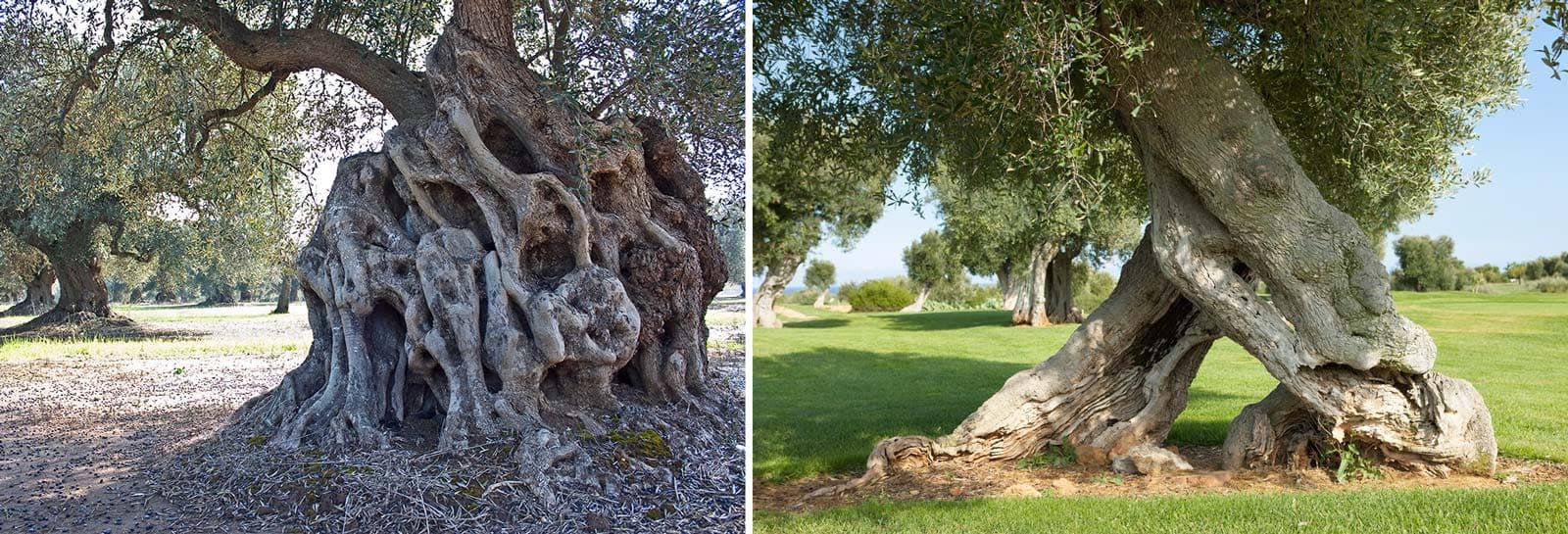
LONGEVITY
With its trunk sculptured by age and its abundance of persistent silver leaves; this legendary tree potentially surpasses the longevity of the Oak tree. Surrounded by legends, the thousand-year-old Olive tree is a symbolic tree and the civilisations around the Mediterranean who feed from it all possess the same ancestral gestures for its cultivation. Unfortunately, it is not possible to know the age of an Olive tree with any certainty.
Dendrochronology (Tree ring dating) cannot be used on the stump of an Olive tree. This variety does not show any net individual growth circles. Consequently, the age of a tree can only be estimated basing on indirect indications (diametre, aspect, historical documents, etc). But these elements are not truly viable and stem from estimations that are sometimes far from the true age of the tree.
In its natural state, when an Olive tree becomes old, it produces shoots (called “suckers”) from its stump and, in this way never truly dies of old age. The new tree that replaces it is not another Olive tree, but a part of itself, a new expression of the same genotype. Nonetheless, the Olive tree can die due to frost, sodden ground, and the failure to succeed in the fight to occupy vital space with contestant species, and probably from drought.
A Provencal proverb says that “Neither the Fig tree nor the Olive tree ever die without heirs”. The oldest trunks that we can observe are nonetheless those of cultivated trees, because the cultivators regularly remove the suckers if they want to conserve the old trunk. If this maintenance is interrupted, the old trees hasten to grow numerous young shoots.
It is said that certain Olive trees on the Mount of Olives in Jerusalem are the contemporaries of Christ. In the south of Libya there is a tree that is 2,700 years old in the village of Chaqra known as the Tree of the Persians. In Roquebrune-Cap-Martin (Alpes-Maritimes), a venerable Olive tree aged over 2,000 years has an impressive diametre of 20 metres with multiple suckers. When approaching the Pont du Gard, three, thousand-year-old Olive trees can be found, one of which was planted in 938 in Spain then brought and transplanted near the Pont du Gard. It was still producing fruit in 2007. The two other Olive trees are approximately from the same era.
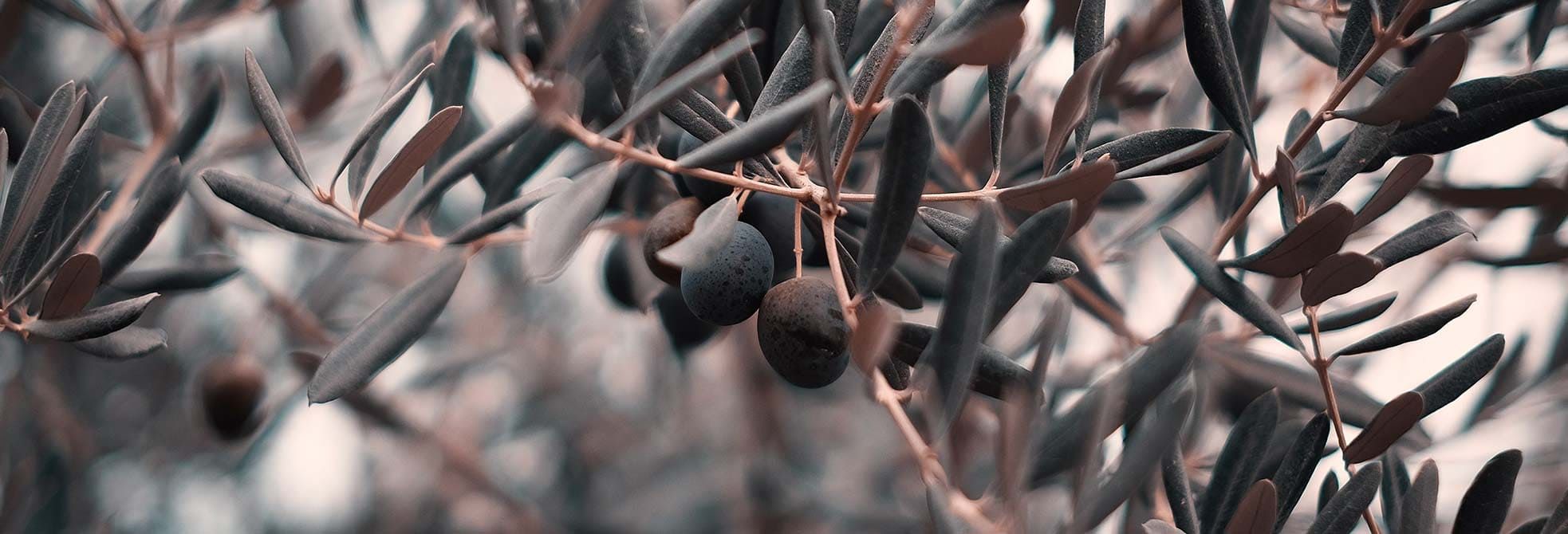
HISTORY AND SYMBOLISM
Ever since Antiquity, the Olive tree that the Goddess Athena brought out of the earth, is the symbol of the Greek town to which she gave her name and represents force and victory, wisdom and fidelity, immortality and hope, riches and abundance.
According to the legend of Cecrops, Athena and Poseidon argued over the possession of Attica. Zeus (the God of the Greek Gods) suggested that they each make a donation to humanity. They chose Cecrops, the first king of the territory to be their arbitrator. Poseidon struck the Acropolis with his trident and made a source of salted water spurt forth and offered a magnificent horse that could carry horsemen and arms, pull chariots, and win battles to Cecrops.
Athena scratched her lance and the immortal tree was born from the soil that was burnt by the sun which would nourish and heal mankind: The Olive tree. Cecrops judged the gift offered by the Goddess to be more useful for his people and it is she who became the protector of Athens. According to Varron, Cecrops asked the inhabitants of Athens to choose their protector. The men chose Poseidon while the women chose Athena, and, more numerous by one vote, tipped the balance in her favour.
Another legend attributes the art of cultivating the Olive tree to Hercules who it is said filled his chariot with young shoots of Olive trees after having completed his ‘famous’ tasks and planted them in the gardens of Olympus.
The Olive tree is also one of the most mentioned trees in the Bible, where the dove released by Noah after the flood returns with an olive branch in its beak, after having found dry land. Or when Jacob anoints the stone of Beth-El with olive oil after his vision of the celestial ladder. Olive oil is used for sacred unction’s in Judaism and Christianity.
Furthermore, on the night preceding his arrest, Jesus chose to meditate and pray on the Mount of Olives. Sacrifice is therefore a symbolic notion of the Olive tree. It was an Olive tree, a Cyprus tree and a Cedar tree that emerged from Adam’s ashes. The Olive tree symbolises peace, reconciliation, blessings and sacrifice and the oil used during these rituals must obligatorily have been pressed by hand.
In the Koran, the Olive tree is a blessed tree, the symbol of universal mankind; and olive oil the source of divine light to guide men to reason through the purity of its oil. According to some, Mohammed said: “Consume the oil (Olive oil) and rub your face with it for it comes from a sacred tree.”
On the United Nations flag, the crown of olive branches circling the globe symbolises universal peace. The green robes of the immortal members of the French Academy owe their name to the green embroidery that decorated these robes which represented the motif of the olive branch. This motive also formally decorated the French franc.
In Japan, it is the tree of amiability and of moral victory, as well as of professional success. Whereas in China it plays the role of protection against poison.
SYMBOL OF LONG LIFE AND HOPE:
The Olive tree is renowned as being eternal. As Herodotus described it; “The Olive tree was burned during the fire in the Athenian temple by the barbarians; but the next day after the fire, when the Athenians, ordered by the king to make a sacrifice, climbed up to the sanctuary, the saw a shoot the height of a cubit sprout from the trunk.”
SYMBOL OF PEACE AND OF RECONCILIATION:
Noah’s Ark: After the flood, the earth was no doubt just an ocean of liquid mud. Sent off to reconnoitre in search of ground on which to rest, the dove returned at the end of the day to Noah’s Ark carrying a fresh branch of an Olive tree in its beak. Noah then knew that the water had receded on the surface of the earth. In this way, the Olive tree was the first tree to grow again after the flood. (Jacques Lacarrière, 1992) – The Symbol of Forgiveness.
SYMBOL OF VICTOIRY:
The Olive tree is a gift full of gratifying signification during the Olympic Games in Athens. A crown made from the Olive tree and jars of olive oil are offered to the winners. The crown of Olive tree branches has become the symbol of the Olympic Games in Athens. No less than five thousand, five hundred and thirteen crowns will be made during these games by volunteers. The branches come from Crete and offered by a sponsor. The crown is a reminder of the ancient tradition of Olympus 2,500 years ago. Created with the branches of the Olive tree that grew near the temple of Zeus, it was the sole reward given to the winners.
SYMBOL OF STRENGTH :
The Olive tree is renowned for its very compact, very heavy, and very resistant wood. It was in Olive wood that the hammers of Hercules were made and with a stake of Olive wood that Ulysses killed the Cyclops in the Odyssey.
SYMBOL OF LOYALTY :
It was also in Olive wood that the bed of Ulysses and Penelope was made, the bed which never received any of the many suitors to the kingdom of Ithaca, during the twenty years absence of this Greek hero.
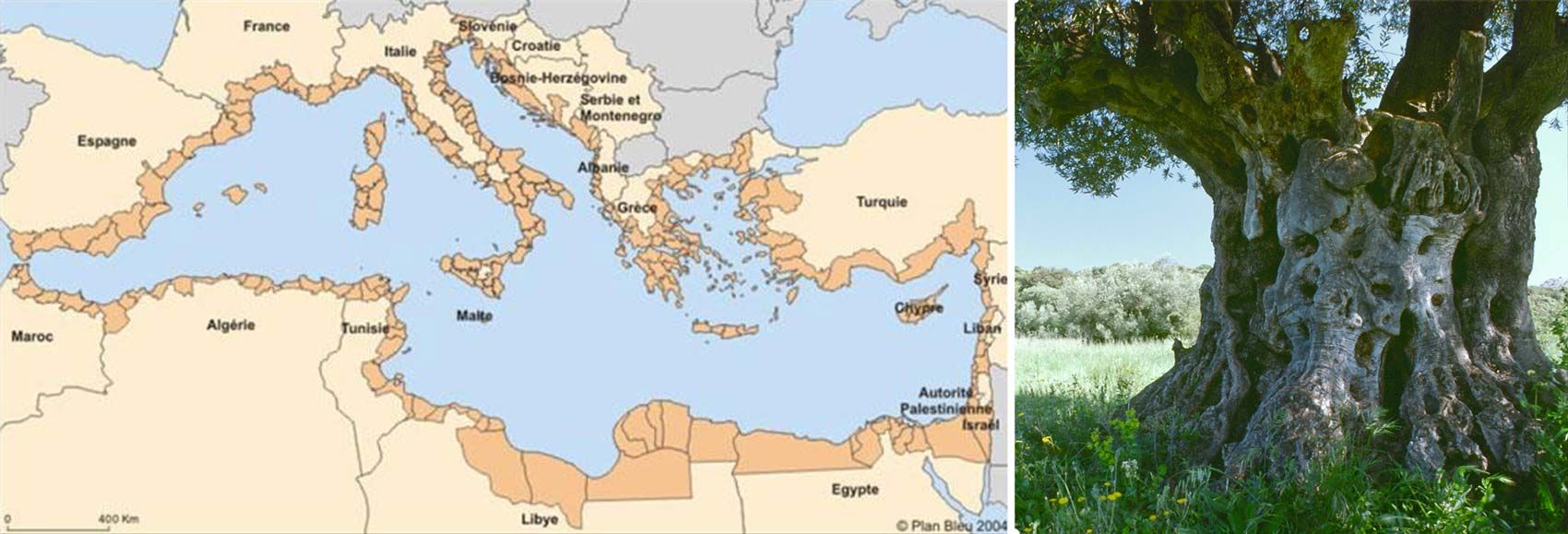
GEOGRAPHY
In France, the olive tree grows mainly along the edge of the Mediterranean, but not only. It can also frequently be found inland in departments such as Ardèche, l’Aude or the Drôme. It grows well between a latitude of 25 to 45 degrees, which furthermore has enabled it to be successfully introduced in Japan, the United States (California), and Mexico for the northern hemisphere, in Australia and various countries in South America for the Southern Hemisphere.
There are about 840 million Olive trees throughout the world, which produce, depending on the years, between 2 and 2.5 million tons of olive oil and 700,000 tons of table olives. More than three quarters of the Olive groves (650 million Olive trees) have been planted in Europe in the countries that surround the Mediterranean: Spain, Italy, Greece, Portugal, France, France, Turkey for the main part.

HEALTH
Olive oil has renowned cholagogue and laxative effects.
It has beneficial properties for health, in particularly on the cardio-vascular level, thanks to its content of Vitamin A, Vitamin E and mono-unsaturated fatting acids.
The benefits linked to these vitamins are above all observed during the consummation of cold olive oil, such as in salads, because the vitamins are destroyed above 40°C. In relation to other unsaturated fatty acids, Olive oil is fairly stable when cooked and, in this case, keeps its beneficial effects on cholesterol.
It is the basic grease matter in the Mediterranean diet (or Crete diet) and has a favourable effect on the prevention of cardio-vascular infections and on the antioxidant capacities of the organism.
Olive oil is traditionally used in the Mediterranean for skin treatments and the fabrication of ointments and soap. Alep soap (Savon d’Alep) and Marseille soap (Savon de Marseille) which contain olive oil and examples of how olive oil is used both for health as for well-being. The Olive tree is used as a medicinal plant, in particularly its leaves which have a diuretic, hypotension et vasodilator effect, and is used in the composition of pharmaceutical specialities. As it is also an anti-diabetic, its indication in the prevention of atherosclerosis is justified.
The young shoots and spring leaves are used in gemmotherapy.

The Olive tree has many branches, a knotty trunk, a brown cracked bark and can reach a height of 15 to 20 metres and live hundreds of years. It adapts easily to arid, stony and barren grounds. Thanks to its ligneous stump in which it gathers its reserves and to its vast network of roots, it is very resistant. However, if the Olive tree retains the water that it has drawn from the ground a long time, it likes water and grows better if it is not lacking any. However, a saturated ground is a fatal danger to the tree. Its resistance to frost varies according to the time of year, the variety, how long the frost lasts and the size of the olive tree. The youngest cannot resist to -6° whereas the older trees can support a temperature of -12° à -15°C.
This tree does not die easily. Effectively, it puts up suckers in the worst conditions and even if its main tronc is dead, others stem from the stump and replace it. The Olive tree is highly aesthetic, and because of this, thousands of olive trees are cultivated for ornamental purposes and incredibly old Olive trees that have sometimes been abandoned on unexploited ground are bought by Nursery garden owners to be replanted and sold.
Certain of these Olive trees are unable to support the move and die, it is then up to me to transform them and give them a second life. Surrounded by legends that go back thousands of years and is a symbolic tree for civilizations all around the Mediterranean. Unfortunately, it is not possible to know the age of an Olive tree for certain. Dendrochronology (Tree ring dating) cannot be used on the stump of an Olive tree. This variety does not show any net individual growth circles.
The age of a tree can only be estimated by basing on indirect indications (diametre, aspect, historical documents, etc). But these elements are not truly viable. In its natural state, when an Olive tree becomes old, it produces shoots (called “suckers”) from its stump and, in this way never truly dies of old age. The new tree that replaces it is not another Olive tree, but a part of itself. Nonetheless, the Olive tree can die due to frost, sodden ground and probably also for reasons of drought.

The Olive tree is classed in the family of Oleaceae which includes, amongst others, Lilacs (Syringa), Privet (Ligustrum), Ash trees (Fraxinus) as well as several shrubs. The gender is called Olea and is composed of 30 different species spread around the surface of the globe.
The variety cultivated around the Mediterranean is Olea Europaea, which includes numerous varieties and produces various shapes and savours of olives stemming from the Oleaster variety, otherwise known as the wild Olive tree.
Certain searchers have recently carried out an inventory and identified 156 varieties including a great number of characteristics relating to the tree, to the fruit bearing branches, the fruit, the inflorescence, down to the leaves and the endocarp.

- Vegetative rest: December-January, for 1 to 3 months.
Germinating activity stopped or slowed down. - Return of the vegetation: End of February, for 20 to 25 days.
Emission of new light-coloured vegetation. - Appearance of floral buds: Mid-March for 18 to 23 days.
Green inflorescence that whitens at maturity. - Blossoming: From the beginning of May to the 10th of June, for 7 days.
Open and clearly apparent Flowers. Pollination and fertilisation. - Fructification: End of May – June.
The petals fall, possible early disaster for flowers and fruit. - Development of the fruit: Second half of June for 3 to 4 weeks.
Small but clearly visible fruit. - Hardening of the stone: July for 7 to 25 days.
The end of the formation of the fruit that have become resistant to cutting and section. - Growth of the fruit: In August for 1.5 to 2 months.
Considerable increase in the size of the fruit and the appearance of lenticels. - The start of ripening: from mid-October to December.
At least half of the surface of the fruit turns from green to a violet red. - Full maturity: From the end of October to December.
The fruit is uniformly coloured in violet to black.

The leaves are positioned opposite each other, of a long oval shape and a shiny dark green on the upper side and light silver green with a medial vein on the lower side. The leaves are persistent, so always green but their duration of life, on an average is limited to three years. During a storm, the leaves turn up to expose the inferior structure to capture water, while their upper side is rather more specialized for photosynthesis. The inferior side is covered with tiny hairs that enable them to retain even the tiniest quantity of humidity while being exposed a maximum to the rays of sun. They measure 3 to 8 centimetres long according to the variety.
The leaves of the Olive tree withhold numerous properties having revealed an antiradical and appeasing activity. Rich in vitamin E and in oleanolic acid, the leaves of the Olive tree have been used for centuries for their properties, both orally and externally in beauty creams. Studies published in Japan in 2002 have proved the efficacy of the extract of olive leaves, in particularly against free radicals.
These are the unstable molecules which are permanently produced by the body. Body cells produce energy from nutrients and from oxygen but leave pollutants behind them: the free radicals. Due to the polluting function of the metabolism, these free radicals are toxic. We produce many more due to pollution, smoke, cigarettes, tiredness, stress, ultra-violet rays, ionising radiation, certain pesticides, solvents, fibreglass, and silica dust.

The flowers are white with a corolla, a calyx with four oval shaped petals. The flowers are grouped into small grapes of 10 to 20 flowers, growing at the junction of the leaves at the beginning of Spring on two-year-old shoots.
Olive trees are auto-fertilising, this is to say that their own pollen can fertilise their own ovaries. Fertilisation is principally made by the wind and only lasts a short week per year. 5 to 10% of these flowers produce fruit for a good production.
Variety of Olives, the vintages:
- The “Aglandau”, very well known in France (Alpes de Haute Provence), is resistant to cold and diseases and gives a good yield of oil. Pronounced gustatory qualities.
- The “Bouteillan”, is very present in the Var, fairly resistant to cold and drought, less to diseases giving an average yield of oil. It has a slight pear taste.
- The “Cailletier”, in the Alpes-Maritimes, has an average resistance to cold and diseases with a good yield of oil, which has a gentle, light taste of almond and hazelnut.
- The “Olivière”, in the Pyrénées-Orientales, offers a good resistance to cold but less resistance to diseases. A less than average yield of oil that has a fruity (tomato) taste.
- The “Picholine”, in Hérault and the Gard. Not very resistant to cold but more resistant to diseases. Fairly good yield in oil. Very fruity and bitter gustatory qualities.
- The “Salonenque”, more particularly grown in the Bouches-du-Rhône. It resists averagely to cold but particularly well to diseases and presents an especially good yield in oil. It has a particularly gentle and delicate savour.
- The “Tanche”, more present in the Vaucluse and in the Drôme, resists averagely to cold and diseases but gives a particularly good yield in oil. Its flavour is gentle and can disappoint amateurs of more full-bodied oil.
- Other fairly well known variétés in France are: The Rougette de l’Ardèche, Négrette, Amellau, Lucques, Verdale de l’Hérault, Grossane, Verdale des Bouches-du-Rhône, Sabine, Germaine, Clermontaise, Ménudal, Rougette de Pignan, Cayon, Petit Ribier, Cayet roux, Brun. But there exist hundreds of others that have not yet been listed.

With its trunk sculptured by age and its abundance of persistent silver leaves; this legendary tree potentially surpasses the longevity of the Oak tree. Surrounded by legends, the thousand-year-old Olive tree is a symbolic tree and the civilisations around the Mediterranean who feed from it all possess the same ancestral gestures for its cultivation. Unfortunately, it is not possible to know the age of an Olive tree with any certainty.
Dendrochronology (Tree ring dating) cannot be used on the stump of an Olive tree. This variety does not show any net individual growth circles. Consequently, the age of a tree can only be estimated basing on indirect indications (diametre, aspect, historical documents, etc). But these elements are not truly viable and stem from estimations that are sometimes far from the true age of the tree.
In its natural state, when an Olive tree becomes old, it produces shoots (called “suckers”) from its stump and, in this way never truly dies of old age. The new tree that replaces it is not another Olive tree, but a part of itself, a new expression of the same genotype. Nonetheless, the Olive tree can die due to frost, sodden ground, and the failure to succeed in the fight to occupy vital space with contestant species, and probably from drought.
A Provencal proverb says that “Neither the Fig tree nor the Olive tree ever die without heirs”. The oldest trunks that we can observe are nonetheless those of cultivated trees, because the cultivators regularly remove the suckers if they want to conserve the old trunk. If this maintenance is interrupted, the old trees hasten to grow numerous young shoots.
It is said that certain Olive trees on the Mount of Olives in Jerusalem are the contemporaries of Christ. In the south of Libya there is a tree that is 2,700 years old in the village of Chaqra known as the Tree of the Persians. In Roquebrune-Cap-Martin (Alpes-Maritimes), a venerable Olive tree aged over 2,000 years has an impressive diametre of 20 metres with multiple suckers. When approaching the Pont du Gard, three, thousand-year-old Olive trees can be found, one of which was planted in 938 in Spain then brought and transplanted near the Pont du Gard. It was still producing fruit in 2007. The two other Olive trees are approximately from the same era.

Ever since Antiquity, the Olive tree that the Goddess Athena brought out of the earth, is the symbol of the Greek town to which she gave her name and represents force and victory, wisdom and fidelity, immortality and hope, riches and abundance.
According to the legend of Cecrops, Athena and Poseidon argued over the possession of Attica. Zeus (the God of the Greek Gods) suggested that they each make a donation to humanity. They chose Cecrops, the first king of the territory to be their arbitrator. Poseidon struck the Acropolis with his trident and made a source of salted water spurt forth and offered a magnificent horse that could carry horsemen and arms, pull chariots, and win battles to Cecrops.
Athena scratched her lance and the immortal tree was born from the soil that was burnt by the sun which would nourish and heal mankind: The Olive tree. Cecrops judged the gift offered by the Goddess to be more useful for his people and it is she who became the protector of Athens. According to Varron, Cecrops asked the inhabitants of Athens to choose their protector. The men chose Poseidon while the women chose Athena, and, more numerous by one vote, tipped the balance in her favour.
Another legend attributes the art of cultivating the Olive tree to Hercules who it is said filled his chariot with young shoots of Olive trees after having completed his ‘famous’ tasks and planted them in the gardens of Olympus.
The Olive tree is also one of the most mentioned trees in the Bible, where the dove released by Noah after the flood returns with an olive branch in its beak, after having found dry land. Or when Jacob anoints the stone of Beth-El with olive oil after his vision of the celestial ladder. Olive oil is used for sacred unction’s in Judaism and Christianity.
Furthermore, on the night preceding his arrest, Jesus chose to meditate and pray on the Mount of Olives. Sacrifice is therefore a symbolic notion of the Olive tree. It was an Olive tree, a Cyprus tree and a Cedar tree that emerged from Adam’s ashes. The Olive tree symbolises peace, reconciliation, blessings and sacrifice and the oil used during these rituals must obligatorily have been pressed by hand.
In the Koran, the Olive tree is a blessed tree, the symbol of universal mankind; and olive oil the source of divine light to guide men to reason through the purity of its oil. According to some, Mohammed said: “Consume the oil (Olive oil) and rub your face with it for it comes from a sacred tree.”
On the United Nations flag, the crown of olive branches circling the globe symbolises universal peace. The green robes of the immortal members of the French Academy owe their name to the green embroidery that decorated these robes which represented the motif of the olive branch. This motive also formally decorated the French franc.
In Japan, it is the tree of amiability and of moral victory, as well as of professional success. Whereas in China it plays the role of protection against poison.
SYMBOL OF LONG LIFE AND HOPE:
The Olive tree is renowned as being eternal. As Herodotus described it; “The Olive tree was burned during the fire in the Athenian temple by the barbarians; but the next day after the fire, when the Athenians, ordered by the king to make a sacrifice, climbed up to the sanctuary, the saw a shoot the height of a cubit sprout from the trunk.”
SYMBOL OF PEACE AND OF RECONCILIATION:
Noah’s Ark: After the flood, the earth was no doubt just an ocean of liquid mud. Sent off to reconnoitre in search of ground on which to rest, the dove returned at the end of the day to Noah’s Ark carrying a fresh branch of an Olive tree in its beak. Noah then knew that the water had receded on the surface of the earth. In this way, the Olive tree was the first tree to grow again after the flood. (Jacques Lacarrière, 1992) – The Symbol of Forgiveness.
SYMBOL OF VICTOIRY:
The Olive tree is a gift full of gratifying signification during the Olympic Games in Athens. A crown made from the Olive tree and jars of olive oil are offered to the winners. The crown of Olive tree branches has become the symbol of the Olympic Games in Athens. No less than five thousand, five hundred and thirteen crowns will be made during these games by volunteers. The branches come from Crete and offered by a sponsor. The crown is a reminder of the ancient tradition of Olympus 2,500 years ago. Created with the branches of the Olive tree that grew near the temple of Zeus, it was the sole reward given to the winners.
SYMBOL OF STRENGTH :
The Olive tree is renowned for its very compact, very heavy, and very resistant wood. It was in Olive wood that the hammers of Hercules were made and with a stake of Olive wood that Ulysses killed the Cyclops in the Odyssey.
SYMBOL OF LOYALTY :
It was also in Olive wood that the bed of Ulysses and Penelope was made, the bed which never received any of the many suitors to the kingdom of Ithaca, during the twenty years absence of this Greek hero.

In France, the olive tree grows mainly along the edge of the Mediterranean, but not only. It can also frequently be found inland in departments such as Ardèche, l’Aude or the Drôme. It grows well between a latitude of 25 to 45 degrees, which furthermore has enabled it to be successfully introduced in Japan, the United States (California), and Mexico for the northern hemisphere, in Australia and various countries in South America for the Southern Hemisphere.
There are about 840 million Olive trees throughout the world, which produce, depending on the years, between 2 and 2.5 million tons of olive oil and 700,000 tons of table olives. More than three quarters of the Olive groves (650 million Olive trees) have been planted in Europe in the countries that surround the Mediterranean: Spain, Italy, Greece, Portugal, France, France, Turkey for the main part.

Olive oil has renowned cholagogue and laxative effects.
It has beneficial properties for health, in particularly on the cardio-vascular level, thanks to its content of Vitamin A, Vitamin E and mono-unsaturated fatting acids.
The benefits linked to these vitamins are above all observed during the consummation of cold olive oil, such as in salads, because the vitamins are destroyed above 40°C. In relation to other unsaturated fatty acids, Olive oil is fairly stable when cooked and, in this case, keeps its beneficial effects on cholesterol.
It is the basic grease matter in the Mediterranean diet (or Crete diet) and has a favourable effect on the prevention of cardio-vascular infections and on the antioxidant capacities of the organism.
Olive oil is traditionally used in the Mediterranean for skin treatments and the fabrication of ointments and soap. Alep soap (Savon d’Alep) and Marseille soap (Savon de Marseille) which contain olive oil and examples of how olive oil is used both for health as for well-being. The Olive tree is used as a medicinal plant, in particularly its leaves which have a diuretic, hypotension et vasodilator effect, and is used in the composition of pharmaceutical specialities. As it is also an anti-diabetic, its indication in the prevention of atherosclerosis is justified.
The young shoots and spring leaves are used in gemmotherapy.
